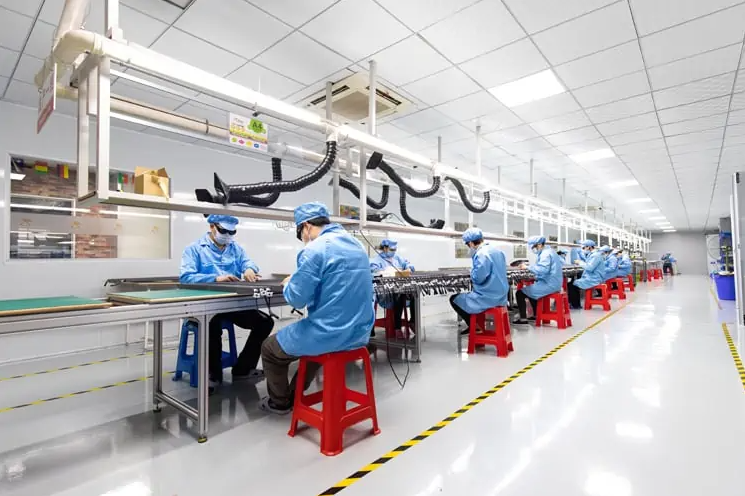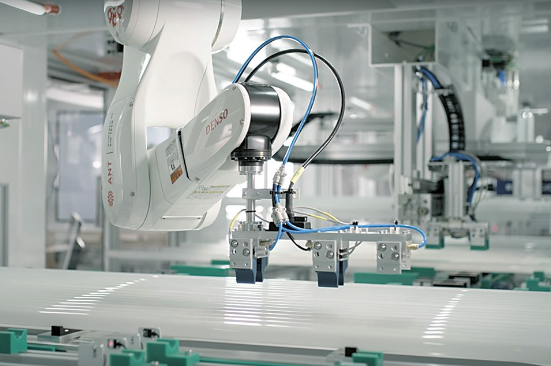I. Introduction
LED lighting has become hugely popular in recent years, primarily because it is energy efficient, long-lasting, and eco-friendly. The benefits of LED lighting have encouraged many countries to switch their traditional lighting systems to LED lighting. However, China has emerged as the most dominant player in LED lighting production globally. This section provides insights into why China is the ideal location for LED lighting factories.
China’s dominance in LED lighting production can be attributed to its low labor and manufacturing costs, extensive supply chain, and advanced technology. These factors make it a hub for LED manufacturers across the world. The Chinese government has also been proactive in offering support to the industry, investing in research and development and providing financial incentives.
China has a massive LED lighting market, and with its sizeable population of over 1.4 billion people, the demand for LED lighting is continually increasing. The Chinese market also provides a testing ground for manufacturers to try out new products and technologies before exporting them globally.
In conclusion, China has become a global leader in LED lighting production due to its low manufacturing costs, advanced technology, and a supportive government. These factors position China as the ideal location for LED lighting factories. The growth of the Chinese LED lighting industry is predicted to continue, presenting immense opportunities for both local and international manufacturers.

II. Finding a Manufacturer
When it comes to finding a manufacturer to produce your products, there are several important things to consider. Here, we’ll discuss the criteria to look for in a manufacturer, how to research and vet potential manufacturers, and how to avoid scams and fraudulent companies.
Criteria to Look for in a Manufacturer
The manufacturer you choose will play a big role in the success of your business. Here are some criteria to consider:
- Quality: The quality of your products will depend on the quality of the manufacturer’s work. Look for a manufacturer with a reputation for producing high-quality products that meet your standards.
- Cost: Of course, you want to find a manufacturer that can produce your products at a cost that is reasonable for your business. Be sure to get quotes from multiple manufacturers to compare costs.
- Communication: Good communication is key when working with a manufacturer. Look for a manufacturer that is responsive, easy to work with, and communicates clearly and effectively.
- Capacity: Make sure the manufacturer you choose has the capacity to produce the quantity of products you require. You don’t want to run into production delays because your manufacturer is overbooked.
Researching and Vetting Potential Manufacturers
Once you’ve established your criteria, it’s time to start researching potential manufacturers. Here are some steps to take:
- Ask for referrals: Talk to other business owners in your industry to see if they have any recommendations for manufacturers.
- Do online research: Use search engines and industry resources to find manufacturers that meet your criteria.
- Check references: Once you’ve identified potential manufacturers, ask for references and follow up with those references to learn about their experiences.
- Visit the manufacturer: If possible, visit the manufacturer’s facility to see their operation in person and ask any questions you may have.
How to Avoid Scams and Fraudulent Companies
Unfortunately, there are many scams and fraudulent companies in the manufacturing industry. Here are some red flags to watch out for:
- Unrealistic pricing: Be wary of manufacturers that offer pricing that is significantly lower than others in the industry.
- Lack of communication: If a manufacturer is unresponsive or vague in their communication, it may be a sign of trouble.
- No physical address or online presence: If a manufacturer doesn’t have a physical address or online presence, it’s best to avoid them.
- Pressure to pay upfront: Be cautious of manufacturers that ask for payment before any work has been completed.
By following these guidelines, you can increase your chances of finding a reputable and capable manufacturer to help bring your products to market.

III. Setting up the Factory
Setting up a factory can be a significant undertaking. There are many factors to consider, including choosing the right location, obtaining necessary permits, selecting the appropriate machinery and equipment, staffing and training the workforce, and implementing quality control measures to ensure a successful operation.
Choosing the Location and Obtaining Necessary Permits
Selecting the right location for your factory is critical. You want to choose a location that is easily accessible to transportation networks and has a reputation for being business-friendly. Additionally, depending on the type of factory, you will need to obtain permits and approvals from various government agencies. It is essential to research and understand the permit process thoroughly to ensure that everything is in compliance with local regulations.
Selecting Appropriate Machinery and Equipment
Selecting the appropriate machinery and equipment for your factory is crucial to ensuring production runs smoothly. You will want to research types of machinery and equipment that are best suited for your factory’s specific needs and budget. Additionally, you should factor in maintenance costs and availability of replacement parts when considering different options.
Staffing and Training the Workforce
Once your factory is up and running, staffing it with competent and knowledgeable employees is vital. Hiring the right people is essential to running a successful operation. You will need to create job descriptions, conduct interviews, and develop training programs to ensure your workforce has the necessary skills to perform their assigned duties.
Implementing Quality Control Measures
Implementing quality control measures in your factory is essential to ensuring customer satisfaction and maintaining profitability. Quality control involves creating procedures and processes to monitor production output and identify areas that need improvement. Regular quality control measures involve inspections, testing, and audits to ensure that products meet your company’s standards.
In conclusion, setting up a factory requires careful planning and attention to detail. By choosing the right location, obtaining necessary permits, selecting appropriate machinery and equipment, staffing and training the workforce, and implementing quality control measures, you can set your factory up for success.

IV. Sourcing Materials and Supplies
As a business owner, sourcing materials and supplies is a critical aspect of operations. Whether it’s for manufacturing or service delivery, finding reliable suppliers is vital to the success of any business. Here are some tips to help you efficiently source materials and supplies.
Finding Reliable Suppliers
There are many suppliers in the market, but not all are reliable. It’s essential to conduct thorough research before engaging any supplier. Here are some ways you can find reliable suppliers:
- Ask for referrals from other business owners who have used similar products or services.
- Attend trade shows or conferences relevant to your industry to meet new suppliers.
- Conduct online searches to find suppliers that match your requirements.
- Check supplier reviews and ratings on third-party platforms such as Yelp or Google.
Negotiating Contracts and Pricing
Once you find a potential supplier, it’s time to negotiate the best deal. Here are some tips to help you negotiate contracts and pricing:
- Research the market price for the product or service to ensure you are getting a fair deal.
- Offer to sign a long-term contract in exchange for discounted pricing.
- Ask for volume discounts if you plan to buy large quantities.
- Be prepared to walk away if the supplier isn’t willing to negotiate.
Keeping an Eye on Market Trends and Advancements
Finally, it’s essential to keep an eye on market trends and advancements. Here are some ways you can stay up-to-date:
- Attend industry conferences to learn about new products and services.
- Follow industry experts and publications on social media to stay updated on new trends.
- Conduct online research to learn about advancements in your industry.
By following these tips, you can efficiently source materials and supplies for your business while staying on top of market trends and advancements.

V. Enhancing Efficiency and Productivity
As a business owner, you want to ensure that your company is operating at its highest level of efficiency and productivity. By implementing the following strategies, you can optimize your production line, reduce waste, and incorporate modern technology into your operations.
Implementing Lean Manufacturing Principles
Lean manufacturing involves a continuous process of identifying and eliminating waste in the production process. This approach can save time and costs, enhance quality control, and improve customer satisfaction. By adopting the principles of lean manufacturing, you can streamline your processes and create a more efficient operation.
Optimizing the Production Line
Improving the flow of your production line can go a long way in enhancing efficiency. Consider reorganizing the layout of your workspace, minimizing unnecessary movement, and reducing downtime. By optimizing your production line, you can reduce the likelihood of bottlenecks in the manufacturing process.
Embracing Automation and Technology
With the rise of Industry 4.0, integrating technology and automation into your business is becoming increasingly important. By embracing new technologies, you can reduce the potential for human error, enhance productivity, and improve the quality of your products. Consider investing in automated equipment that can perform routine tasks and free up your employees to focus on higher-level work.
Incorporating these strategies into your business can result in significant improvements in your efficiency and productivity. By continuously analyzing and optimizing your operations, you can stay competitive and deliver high-quality products to your customers.

VI. Meeting Regulatory Standards and Certifications
As a responsible business, we understand the importance of adhering to regulatory standards and obtaining relevant certifications. Our commitment to meeting these requirements goes beyond mere compliance, and extends to ensuring the highest standards of safety and environmental responsibility are upheld.
We keep ourselves updated with the latest changes in regulations and ensure our practices are always in line with the requirements set by relevant authorities. Our team works diligently to obtain the necessary certifications and approvals that demonstrate our commitment to quality and compliance.
In addition to meeting regulatory requirements, we strive to exceed expectations when it comes to environmental and safety standards. Our processes and protocols are designed to minimize our impact on the environment and ensure the safety of our employees and customers.
At [Company Name], we take our obligations regarding regulatory compliance seriously, and we continuously work to improve our practices to meet the evolving standards.
VII. Managing Finances and Cashflow
As a business, managing finances and cashflow is of utmost importance. It is important to keep track of every penny spent and received, which is why creating a budget and forecast for the factory is crucial. This will help you plan and make financial decisions effectively.
Additionally, maintaining a healthy cash flow is crucial to the success of your business. You need to make sure that there is sufficient cash available to meet your financial obligations. Make sure to keep track of your income and expenses and ensure that your business has enough working capital at all times.
Handling payments, taxation, and import/export duties is also an integral part of managing finances. Make sure to pay your bills on time, file your taxes accurately and on time, and ensure that you are aware of import/export duties to avoid any unforeseen costs.
By effectively managing finances and cashflow, you will be able to ensure the long-term success of your business.

VIII. Promoting and Marketing the Products
As a business owner, it is essential to create a strong brand image that distinguishes your products from competitors. This can be achieved by developing a unique brand identity that resonates with your target audience. You should create a consistent brand image across all marketing materials, including logo design, packaging, and advertising.
Identifying market opportunities and niches is another crucial aspect of promoting and marketing your products successfully. By conducting market research, you can assess customer demand, identify potential gaps in the market, and tailor your marketing efforts to meet specific customer needs. This helps you develop products that target specific niches or capture untapped markets.
Digital marketing strategies are critical for attracting customers in today’s digital age. You must utilize various digital marketing channels, including social media platforms, email marketing, and search engine optimization, among others. These channels help you reach a broader audience and increase visibility, ultimately driving sales and revenue.
In conclusion, promoting and marketing your products require a robust brand image, identifying market opportunities, and utilizing digital marketing strategies. By incorporating these elements into your marketing plan, you can increase brand recognition, customer engagement, and, ultimately, sales growth.
IX. Conclusion
In conclusion, this article has covered the essential aspects of developing an LED lighting factory in China. The key points discussed included the significance of conducting thorough research, the importance of building strong relationships with suppliers, and the need to remain adaptable. While setting up a factory in China may seem daunting, it can be an incredibly lucrative venture. We encourage those considering this path to take action and start exploring the opportunities that await them in the Chinese market. Remember, nothing worthwhile is ever achieved without taking a bit of risk!



